Fortunately Pete arrived and laughed at my paranoia! I was relieved that Pete had not adopted any of the ethnic paraphernalia of necklaces and bracelets that so many travellers seem to where as some form of uniform emphasising the fact that they have seen the world.
Adjusting to Latin American time seemed to be a bit of a challenge – I was definitely feeling that we should be up having breakfast at 4am in the morning! Eventually it got to a respectable time of the day and we had breakfast and took a taxi into Lima – I still couldn’t quite get over the hectic honking and ramming cars.

Plaza de Armas, Lima
We got to the central square, where there seemed to be some from of minor demonstration going on, we couldn’t quite work out what it was for but there seemed to be a lot of armed police and vehicles not so inconspicuously tucked away down the side streets. Deciding that we should do something cultural we visited Lima Cathedral, which was adorned with opulent art work and decoration; I found this kind of wealth of the church ironic compared to the local population.
Carrying on with the culture we visited the museum of congress and the inquisition, Pete got very excited about the various dungeons and torture implements on display, think it must be a vet thing.
Overall, Lima was certainly a busy metropolis but incredibly polluted and we decided to get out the city sooner rather than later.
Deciding to travel in a bit more comfort we took a “Royal Class” bus to Pisco - this meant we got slightly bigger seats, a suspicious looking ham and cheese sandwich and an appalling movie. Driving out of Lima you could see the shanty towns built on the outskirts of the city, the government had made the communities life easier by erecting flights of yellow wooden steps amongst the terraces of corrugated iron, tyres and chip board.
The drive through the countryside was not at all what I’d expected, I guess the tourist photos of Peru you see are all of the lush forest and higher land which incorporates spots like Machu Picchu. The landscape was pure desert; I had never been anywhere before where there were just no signs of plant life, the bleakness of the place was compounded by the grey sky which merged into the grey sand of the desert. The only signs of productivity from this harsh environment were the chicken sheds along the roadside.
After three and half hours of travelling we arrived in Pisco, which is a small town south of Lima, the atmosphere was a lot more laid back than that of Lima and we checked into the spacious Pisco Hostel. That evening we wandered around the vibrant town and booked a trip to the Ballestas Islands and the Paracas National Reserve the next day.
We had an early start at 7am when a mini bus took us to Paracas where we got on a small motor boat. We were instantly treated to a swim past of a pod of bottle nosed dolphins literally 200m from leaving the jetty - the trip had already been worth it. We then made it out to the islands along the coast so we could view the “candelabra” which had been carved out of the ground by the Paracas people 1200 years ago. It is thought to be symbolic of the San Pedro Cactus, which is a plant that induces hallucinations and used in shamanistic rituals.
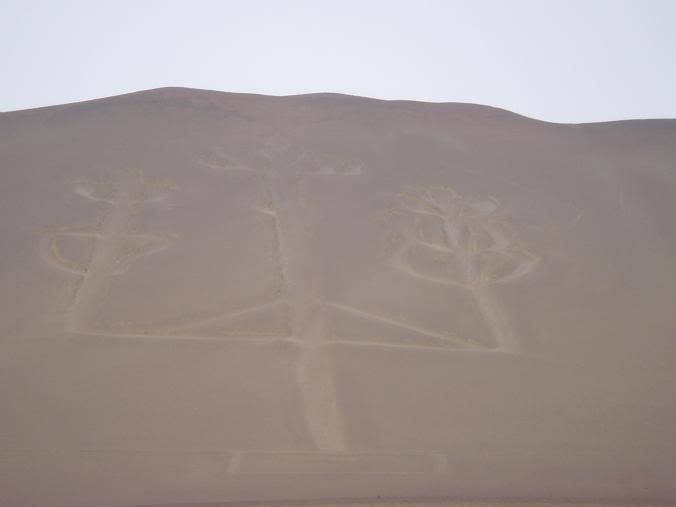
The islands are an important breeding ground for sea lions and nesting colony for all kinds of sea birds including Humbolt penguins, Inca terns (our favourite), Pelicans, Peru Boobies (a bit like a gull) and various cormorants. We were also treated to an amazing display of sea birds feeding, on a shoal of fish diving bombing from a great height accurately catching their prey amongst the frenzied chaos of wings and water. We returned to shore where we joined a bus for the tour of the national park.

Paracas coast
The Paracas park was an area of great contrast - the land was fairly devoid of any biodiversity except for the occasional distant flamingo which can tolerate the harsh saline conditions. The soil is too poor and too salty to support many terrestrial plants (so much salt that the road surfaces were made out of compacted salt). This was a complete contrast to the rich sea which contained over 200 different species of seaweeds and a whole variety of marine animals and sea birds, all fed by the Humbolt current which bathes the western coast of South America.
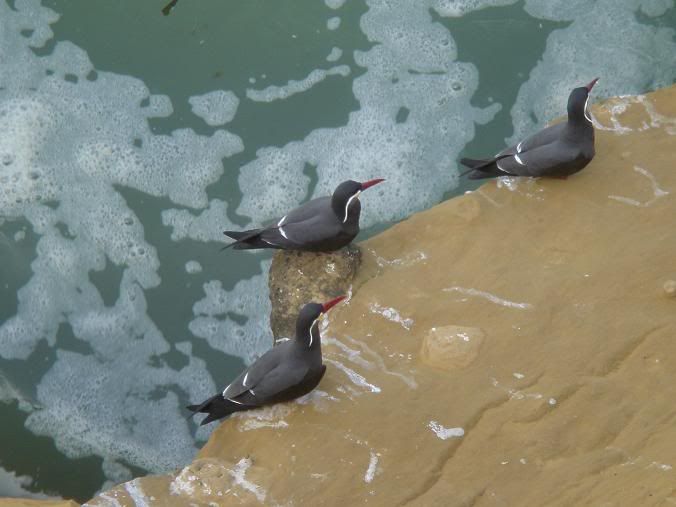
Hannah's favourites - Inca terns
On returning to Pisco we decided to take of advantage of the happy hour in our hostel and I was treated to my first Pisco sour, a Peruvian cocktail consisting of Vodka, syrupy water stuff, lime and a whipped egg yoke - “sour” was certainly an appropriate name!
The next day we took a 2 hour bus to Ica, then immediately jumped into a taxi to take us out to the desert oasis of Huacachina, some 4km from Ica. Huacachina is a small village which centres around a stereotypical lagoon bordered by palm trees and exists on the income from the gringos who come to go dune buggying and sand boarding in the surrounding mountains of sand.
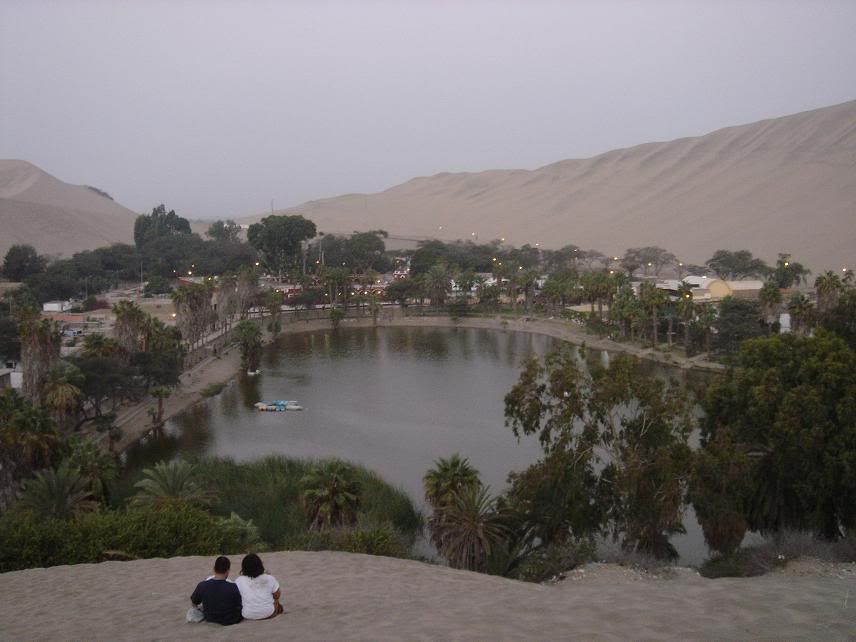
Huacachina
We checked into a hostel and went to book a dune buggying and sand boarding trip for that afternoon. At 3pm we met at a neighbouring hostel and piled onto the buggies with 6 other gringos and our driver – who promptly zoomed off into the dessert. Dune buggying is most similar to being on a roller coaster flying up and then down huge dunes with near vertical faces - it was excellent fun. We then stopped at the top of a steep dune with several other buggies full of gringos and we all threw ourselves down the dune on board; fortunately landing on the sand was definitely softer than falling on snow! We then watched the sun go down behind the dunes and enjoyed another adrenaline packed ride back to Huacachina.

Sand mountains!
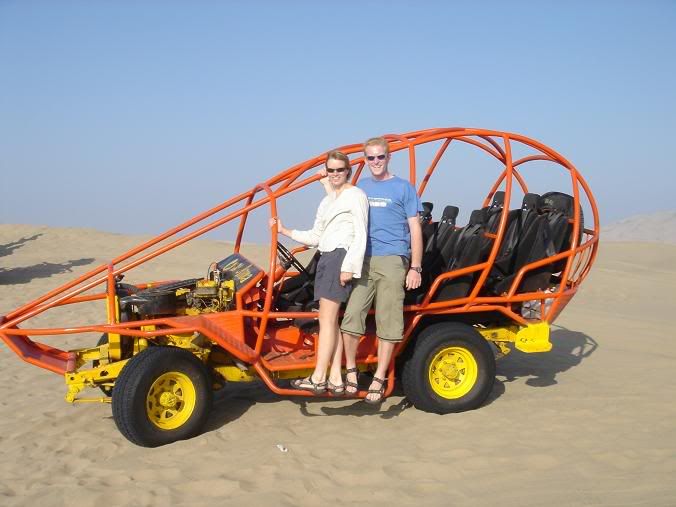
This used to be a Skoda
The following morning saw us trying to arrange a telephone interview for a ski job, but the phone lines were all down in Huacachina. We rapidly packed and got back to Ica, where we made our call from the bus station - only to postpone the interview. This was also the morning I found about my credit card being cloned - I'd love to tell you more but it's a total shambles, and the less said the better. Instead, we caught a bus to Nasca that arrived around lunchtime and found ourselves a nice hostel – albeit with water supply problems. We weren’t planning on staying long so booked a flight as we arrived over the famous Nasca Lines – a series of geometrical shapes and animal figures etched into the surface of the nearby desert.
The lines originally to public attention when Eric von Daniken proclaimed them to be alien spaceship landing strips; since then, many other theories have come and gone. One of the most abiding is that of Maria Reiche, a German archaeologist who spent her life studying the lines, who thought them to be a astronomical calendar. The most current – and widely accepted – theory is that the lines were processional features marked out to draw the attention of the Gods to the area; during times of drought the landscape was used as a large scale map of their surrounding area, the lines being markers as to where water was needed. As hard as the Nasca people may have tried, it appeared their efforts were in vain – their culture died out before the Incas.

If you look really hard...... it's a hummingbird
The flight was good – another rollercoaster ride. It was Hannah’s first time in a Cessna and she felt she had been in more structurally sound 2CVs – especially when we were banking hard to see the animals from both sides of the plane.
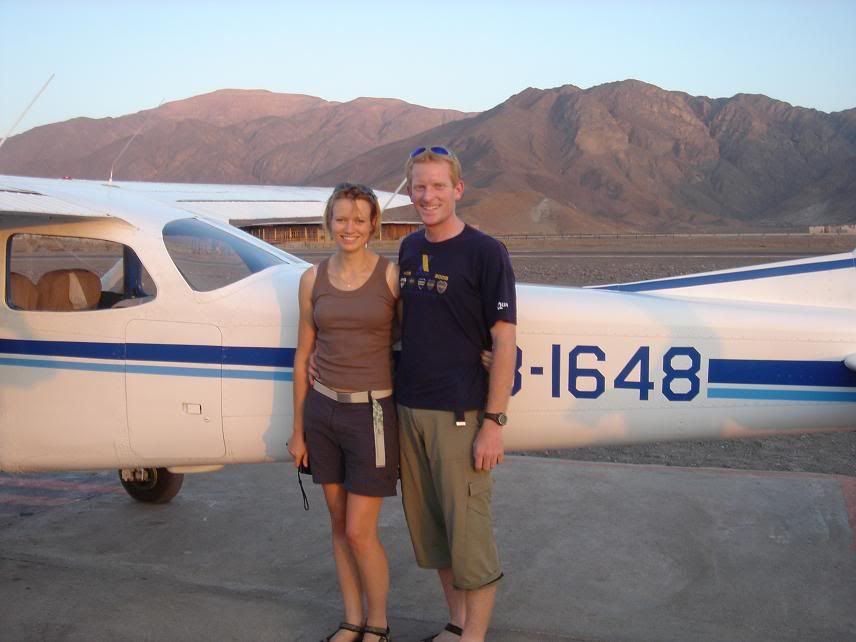
2CV with wings
We spent the following day waiting to take an overnight bus to Arequipa, second city of Peru. We spent the day looking around town – it was a pretty relaxed place with a nice market. Our night bus was not up to the standards I enjoyed in Chile and Argentina, but it wasn’t bad – and it’s always nice having someone to lean on!
In Arequipa we installed ourselves in a hostel with “the best breakfast in Arequipa” – Hannah’s choice. We had a look around town and sorted out a 3 day trip to the Colca Canyon for the following day. The centre of Arequipa is a World Heritage Site – despite the fact it has been destroyed three times since it was founded by earthquakes (there was a long tremor 2 hours before we arrived in town). The local building material of white sillar is used almost exclusively in the centre, and there is an imposing Plaza de Armas and cathedral.
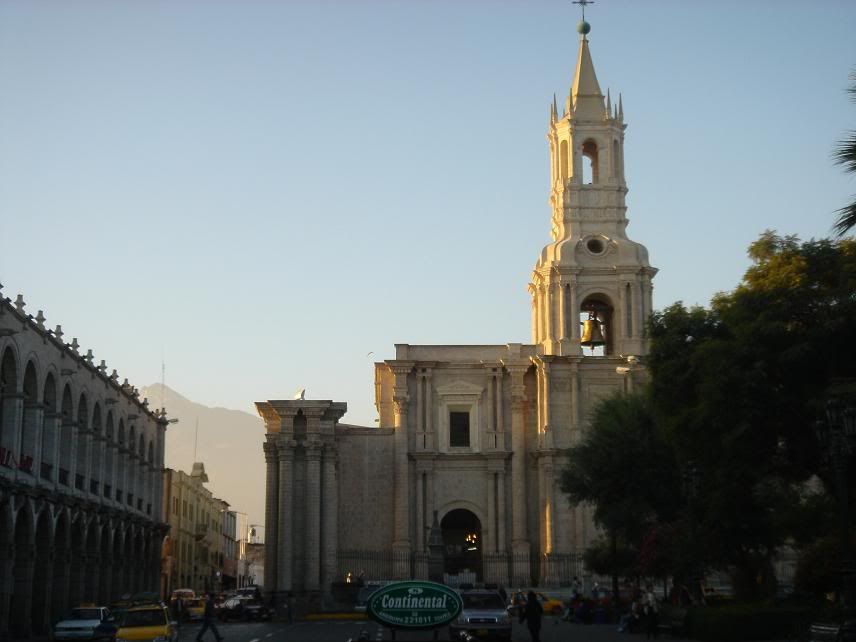
Plaza de Armas, Arequipa
We put off the Colca Canyon tour for a day as I was feeling rough – instead we visited the Santa Catalina convent, a small city-within-a-city that was several hundred years old. The 2 hectare convent still has some 30 nuns living in seclusion, but the majority of the site has been restored and opened to the public. The architecture was amazing, and there was a warren of tiny courtyards and cloisters, divided by narrow cobbled streets and brightly painted walls. It was great.

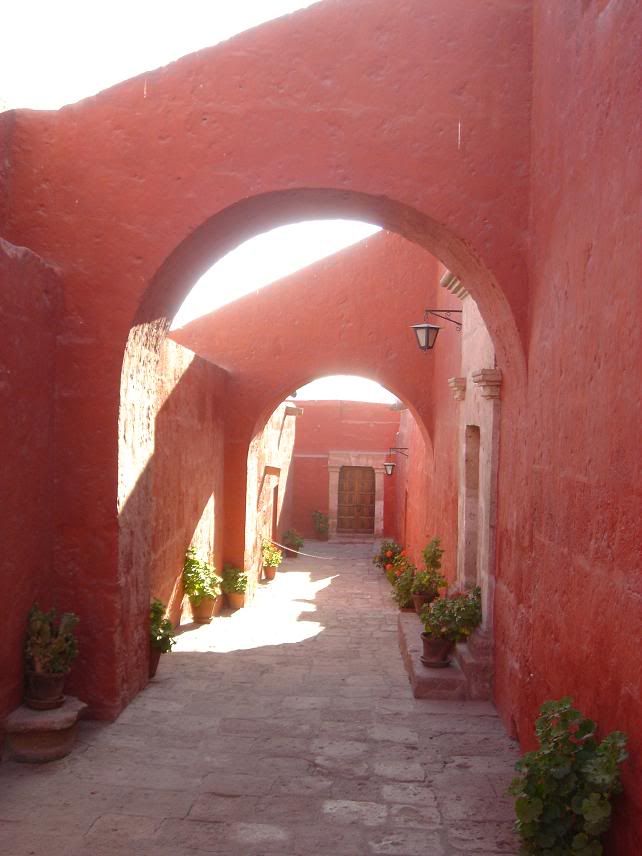
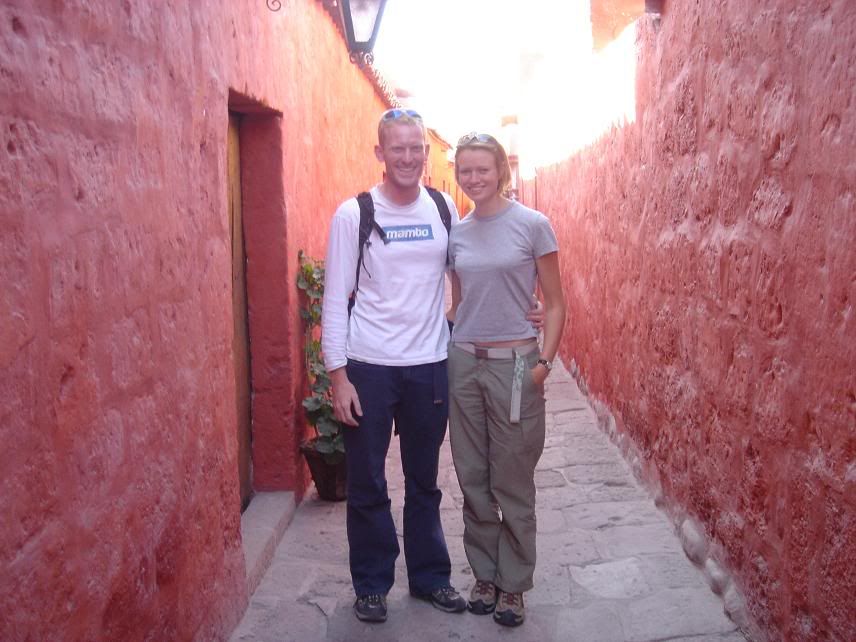
The following morning we departed bright and early for our Colca Canyon trip. The initial journey there was by public bus, and the bumpy, dusty 5 hour ride was totally enjoyable - although we reach an altitude of 4800m, from where the road started a long and winding descent into one of the deepest canyons in the world.
We arrived in the town of Cabanaconde for lunch, as a local festival to some Virgin Saint or other was being celebrated. The costumes and music - a massed brass band - were great. We started out after lunch on a steep and dusty track down into the canyon. From Cabanaconde - already some 1500m down in the canyon - we dropped another 1000m to the river at the bottom, passing sheer walls, condors and a good few pack donkeys en route. There was a suspension bridge at the bottom to cross, after we we climbed briefly to reach a small village. Here the vegetation was a lot more lush than higher up, and citrus fruit groves, small fields of wheat and opuntia cacti covered in coccinea beetles made up the agriculture. We trekked on to another village named Cosñirhua, where we were to stay for the night in a mud shack with a bamboo floor - Hannah thought it was really romantic.
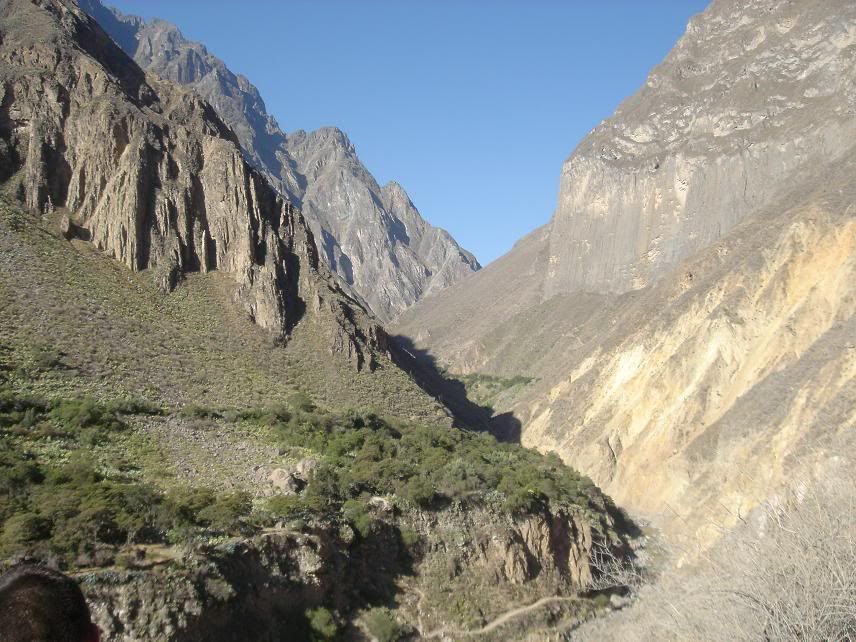
Walking down the canyon
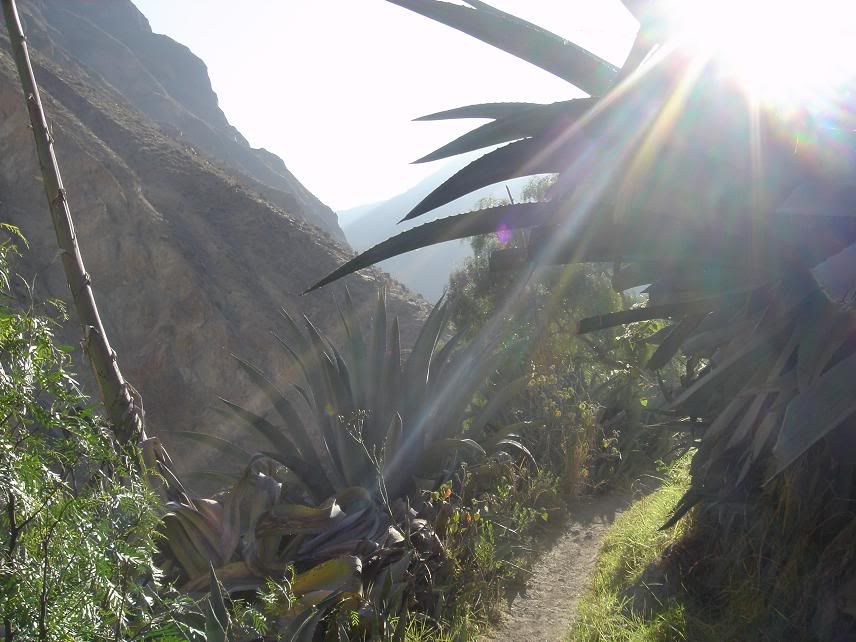
Agaves in the evening light

Local lady cooking our breakfast

Wheat field in the canyon
After a cold night we arose early for a walking tour of the village farms by a local man. It was really interesting, and we tried avocados, oranges, apples, lemongrass and some fruit that looked like a bean crossed with a banana. After breakfast we then continued on our trek, arriving after an hour and a half back at another suspension bridge to recross the river. This time, however, the crossing was a little more fraught - there is something less than reassuring about crossing on the cables because the planks have been removed, whilst laborers drill away at the foundations on either side.
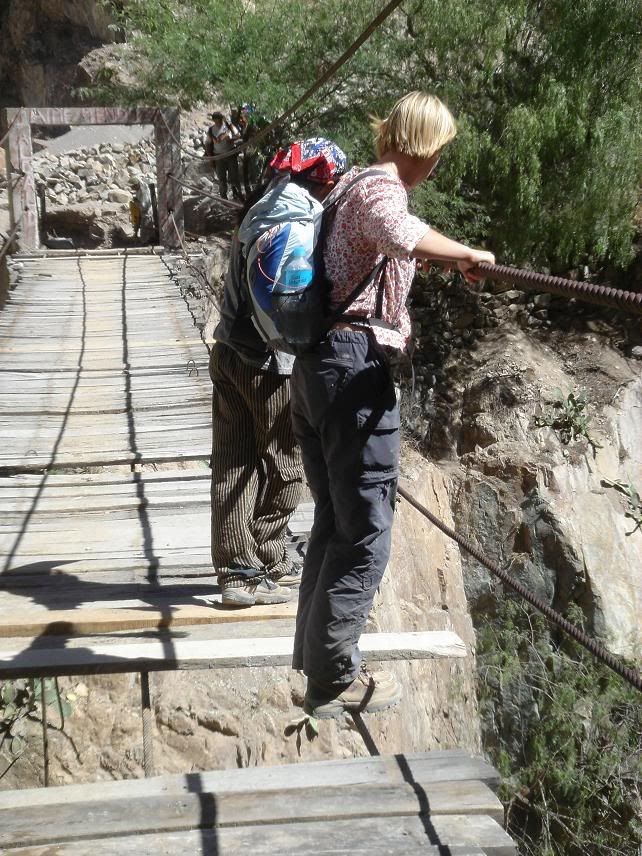
Without a hitch our group arrived on the other safely, and carried on to the small tourist spot aptly named "Paradise". A spring fed pool, palm trees, bamboo shacks and llamas and sheep grazing around made for a very relaxing afternoon.
The next day was anything but; we got up at 2.30am - officially silly o'clock in my book - and started the 3 hour uphill walk to Cabaconde. We made it in 2 hours, then sat for an hour freezing waiting for the rest of the group, after which we were thankful for the warm breakfast supplied in town. But 7.30am we were off again, this time to visit Cruz del Condor - a narrow spot in the canyon where condors (and tourists) tend to congregate in the morning. We were not incredibly lucky - there were about 6 in the distance, but only saw 4 up close.
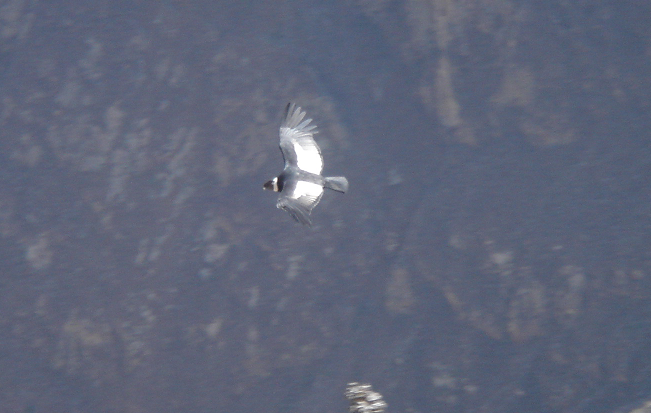
We boarded another bus to reach the town of Chivay, lunch stop on our route back to Arequipa where we were able to enjoy a hot spring swimming pool before taking a much less crowded bus back to our hostel. We arrived back tired and looking forward to a hot shower and bed, only to find our reservation had vanished and the hostel full.
As I said, there's always something.

3 comments:
aw, you guys! as always, a great read and great photos, lovely to see what you're up to. don't feel to jealous now we're starting to pack up, sell up and think about our own exotic journey. lots of love, jen x
You guys are the luckiest people! still loving the photos and write-ups. Hannah- best thing to do is place your money belt in the loo, or at least this was my accidental solution in LA.
I have installed a PC at Granny's just so she can read your blog! Love from Dave and Win.xx
Great blog! I also have a site about cables water ski
. You can check it out at cables water ski
.
Also, as a special bonus, I want to tell you about a great site that is giving away a FREE Sony DVD Handycam. Just click the link below and enter your Zipcode to qualify.
FREE Sony DVD Handycam
Post a Comment